St. Clement Danes is a prominent landmark in the Strand, opposite the Royal Courts of Justice. This photo from the book Wonderful London shows the church and the surrounding landscape in the 1920s:
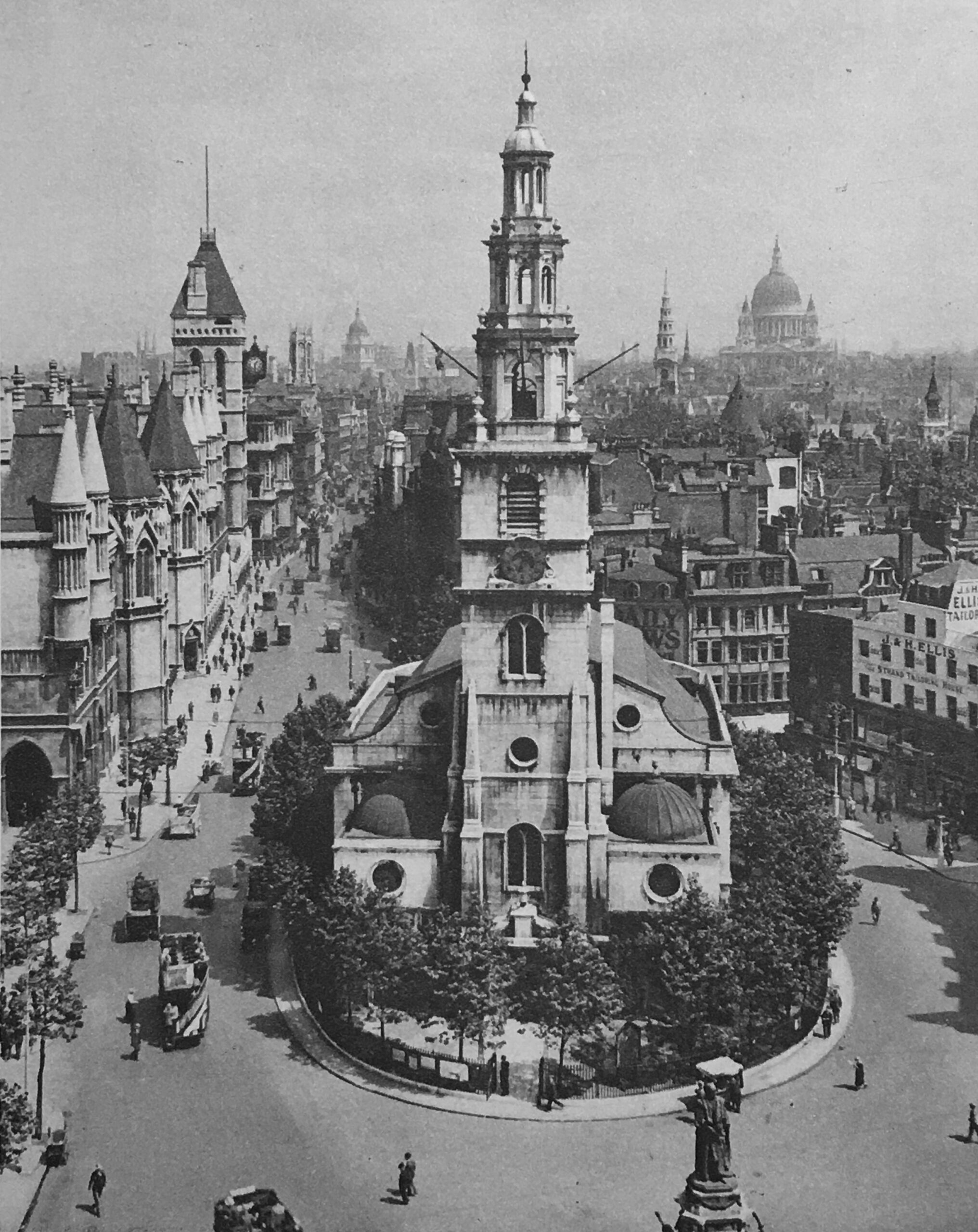
The caption with the photo reads: “The church, which stands on an island in the traffic, has part of its name from the fact that in a previous church on that site a number of Danes were buried. The Saint’s name is popularised in the nursery rhyme of “Oranges and lemons” whose tune the bells still chime. The present structure is from designs by Wren and dates from 1681. On the left are the Law Courts and just to the right of the projecting clock are St. Dunstan’s in the West and the distant dome of the Old Bailey. The wedding-cake steeple of St. Bride’s is to the left of St. Paul’s dome.”
There is a plaque inside the church which adds to this history: “The original church founded on the site of a well outside Temple Bar was by tradition built in the ninth century. Repaired by William the Conqueror and rebuilt in the fourteenth century. That church was pulled down and rebuilt in its present form by Sir Christopher Wren in 1681. The steeple was added to the tower by James Gibbs in 1719. The church was destroyed by enemy action in 1941. The walls and steeple left standing, restored and rededicated as the central church of the Royal Air Force in 1958”.
In the above two descriptions of the church there are two different origin stories, one that the church was built on the site where Danes were buried, the other that it was founded on the site of a well.
Ben Weinreb and Christopher Hibbert in the London Encyclopedia take the Danish route, although stating that the association with the Danes is obscure, although according to John Stow it is so called because “Harold Harefoot, a Danish King, and other Danes were buried here.”
An article in the Illustrated News on the 1st of October 1842 also includes a Danish reference:
“It would seem, according to William of Malmsbury, that there was a church here before the arrival of the Danes, and that they burnt it, slaying the monk and abbot, and, marching off, continued their sacrilegious fury throughout the land; at length, desirous to return to Denmark, when they were all slain at London, at a place which has since been called the Church of the Danes.
Fleetwood’s account is that, when most of the Danes were driven forth of this kingdom, the few that remained (being married to Englishwomen) were compelled to reside between the Isle of Thorney (Westminster was so called) and Caer Lud (or Ludgate).”
That is the problem with anything with roots in the early medieval period. There is very little firm evidence to confirm whether there was a church here before the Danes, whether a well was here, or whether a Danish King was buried on the site, however there was a much later well, which I will discover later.
St. Clements Danes is though on a important route. The Strand has been part of the route between the City of London and Westminster for centuries, and continues to be a key route between these two historic parts of London.
Land from the Strand descends down to the River Thames, and the Strand would have been the dry, high ground along the river. The name Strand comes from old English, Germanic and northern European meanings of a beach, the edge of a sea shore, or the shoreline. In the Netherlands the word Strand is still used for a beach.
The church is also on the south eastern edge of a small patch of high ground rising around Houghton Street, and would have been an ideal place to settle, between the City and what would become Westminster, on high ground above the River Thames.
I cannot take a photo from Australia House as in Wonderful London, however my view of St. Clement Danes from the Strand is shown below:

Today, the Strand runs either side of St. Clement Danes, with Aldwych curving north from the eastern side of the church, and the Strand continuing to the south.
The church has not always had this island location, although it has been in a prominent place on the Strand, and where a road leading of the Strand turned north, via Butcher Row, Back Side, Wych Street and then into Drury Lane.
The following extract from Roqcue’s map of 1746 shows St. Clement Danes to the right with these streets running off to the north. The wonderfully named Back Side was probably a descriptive reference to the street being on the back side of the church, with a narrow row of buildings being between street and church.

The transformation of the church to being on an island location, and the widening of the streets on either side of the church has taken place over the last couple of centuries. The following print from 1753 shows the church not long after Roque completed the map shown above (© The Trustees of the British Museum).
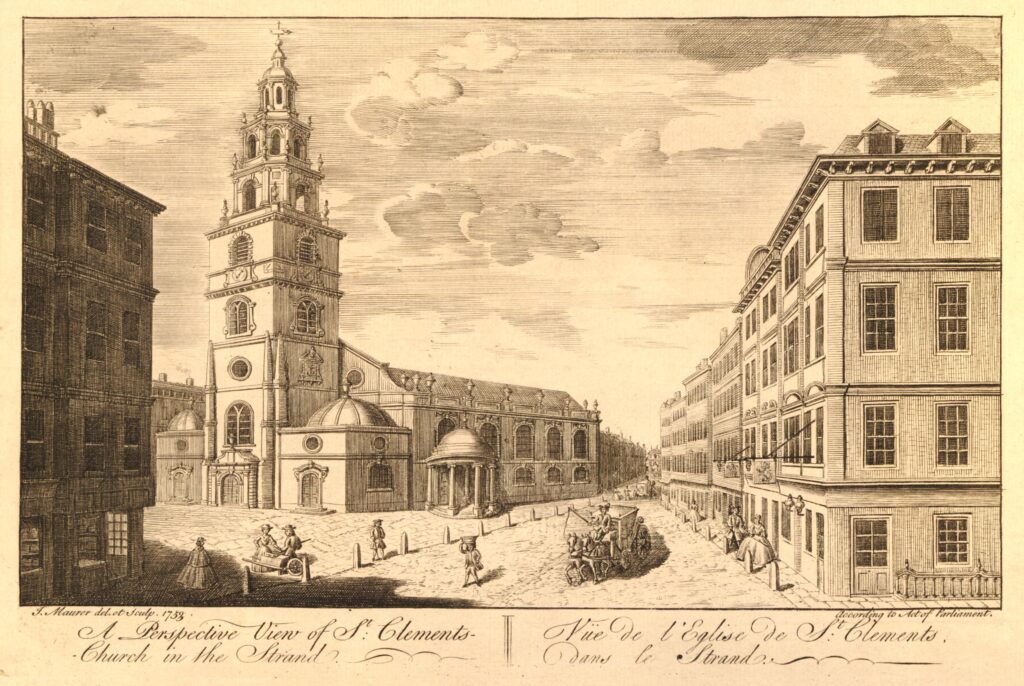
Clearance of the land to the south started in the early 19th century. The following print shows the buildings to the south and the map below shows the outline following demolition, but also shows the occupants and business in the houses in 1810. The corner of St Clement Danes is on the right (© The Trustees of the British Museum).
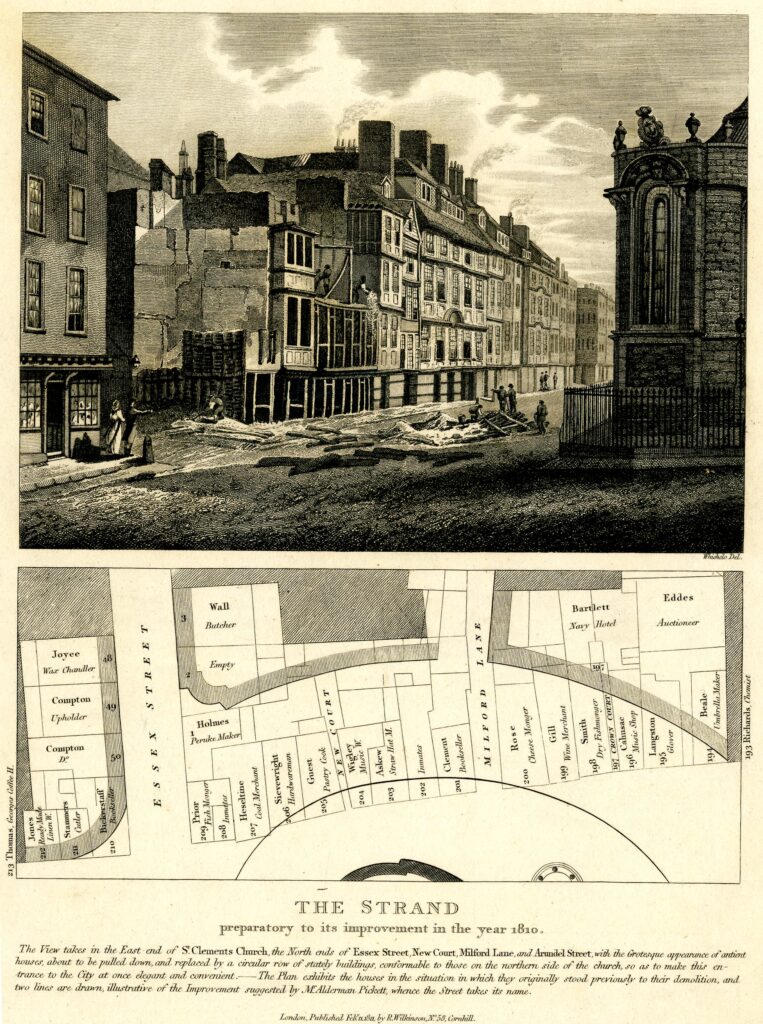
I have extracted the section of the demolished houses and rotated to make it easier to read the occupants and the trades, which included Fish Mongers, a Cheese Monger, Pastry Cook and a Straw Hat Maker.
The church avoided the 1666 Great Fire, but was rebuilt soon after in 1681 due to the state of the previous church, however the church was destroyed by fire during the last war. Only the steeple and the outer walls of the church survived, so the interior we see today is the post war reconstruction of St. Clement Danes.

Coat of arms on the ceiling. The writing in the blue section at the bottom is in Latin and translates as “Christopher Wren built it in 1672. The thunderbolts of aerial warfare destroyed it in 1941. The Royal Air Force restored it in 1958”:
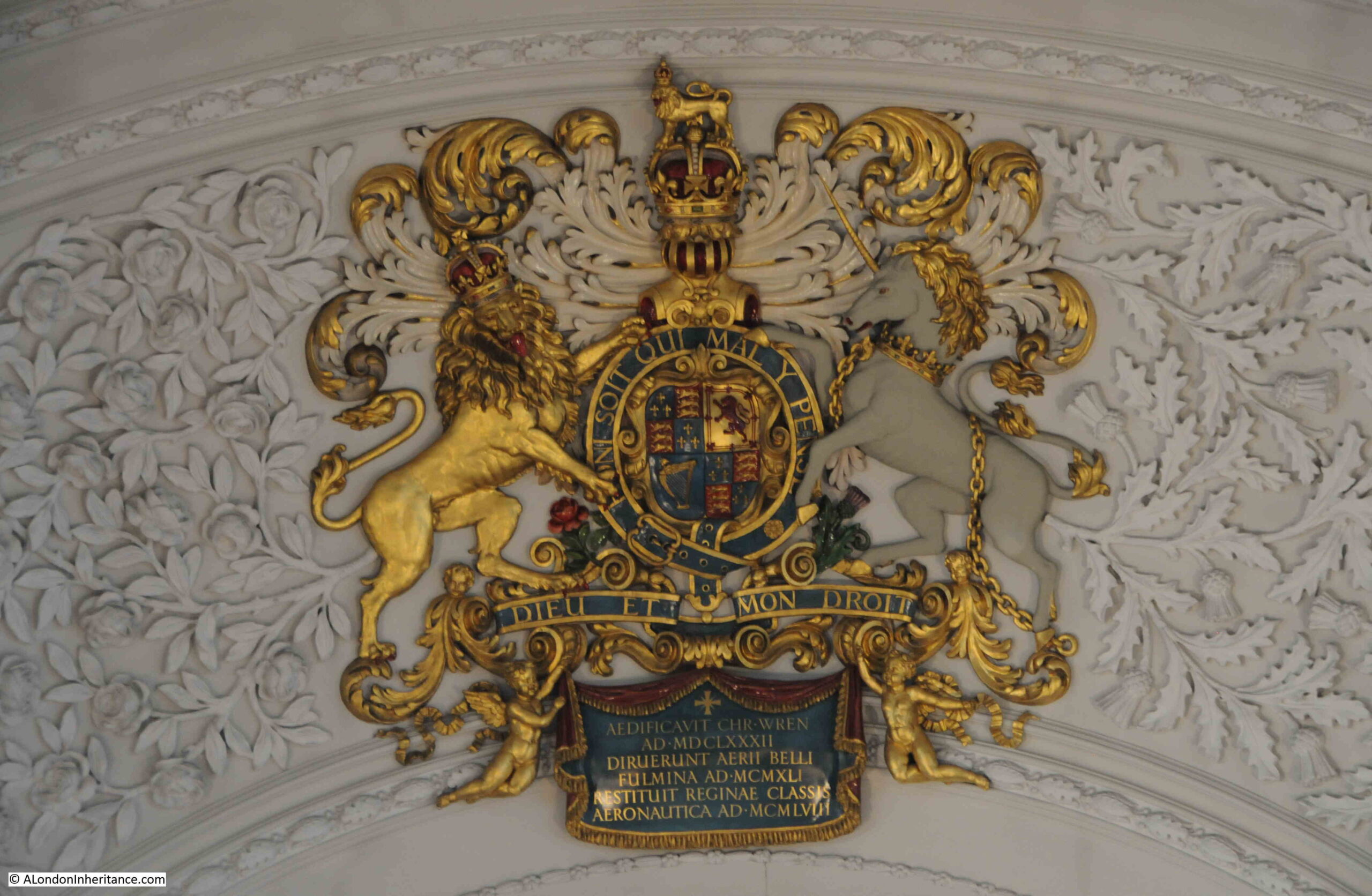
Stained glass window showing St. Paul’s Cathedral:
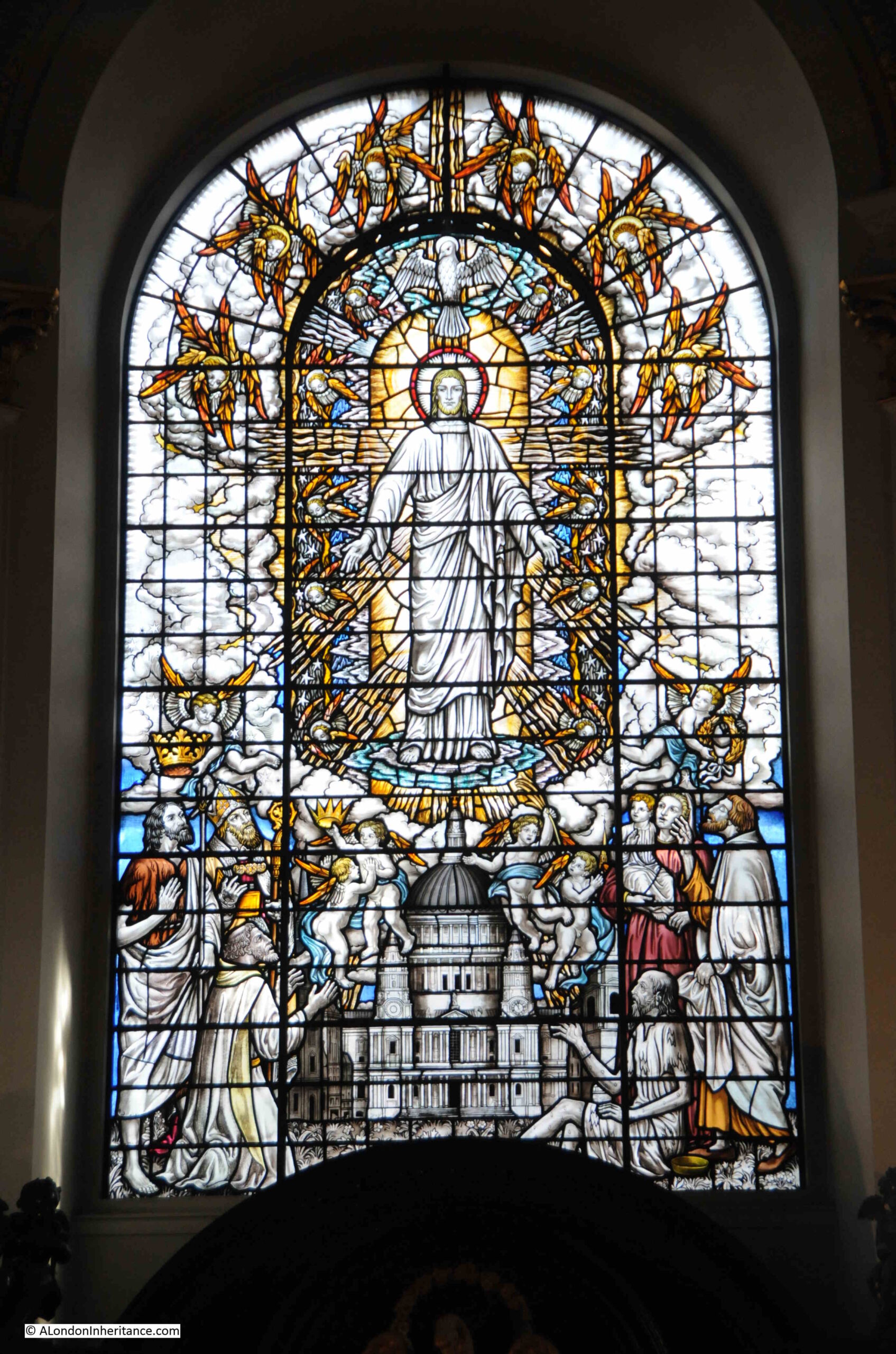
Following wartime damage and restoration, St. Clement Danes was re-consecrated in 1958 as a perpetual shrine of remembrance to those who have died in service in the RAF, and RAF symbolism can be seen throughout the church.
This includes over one thousand slate squadron and unit badges embedded in the floor:
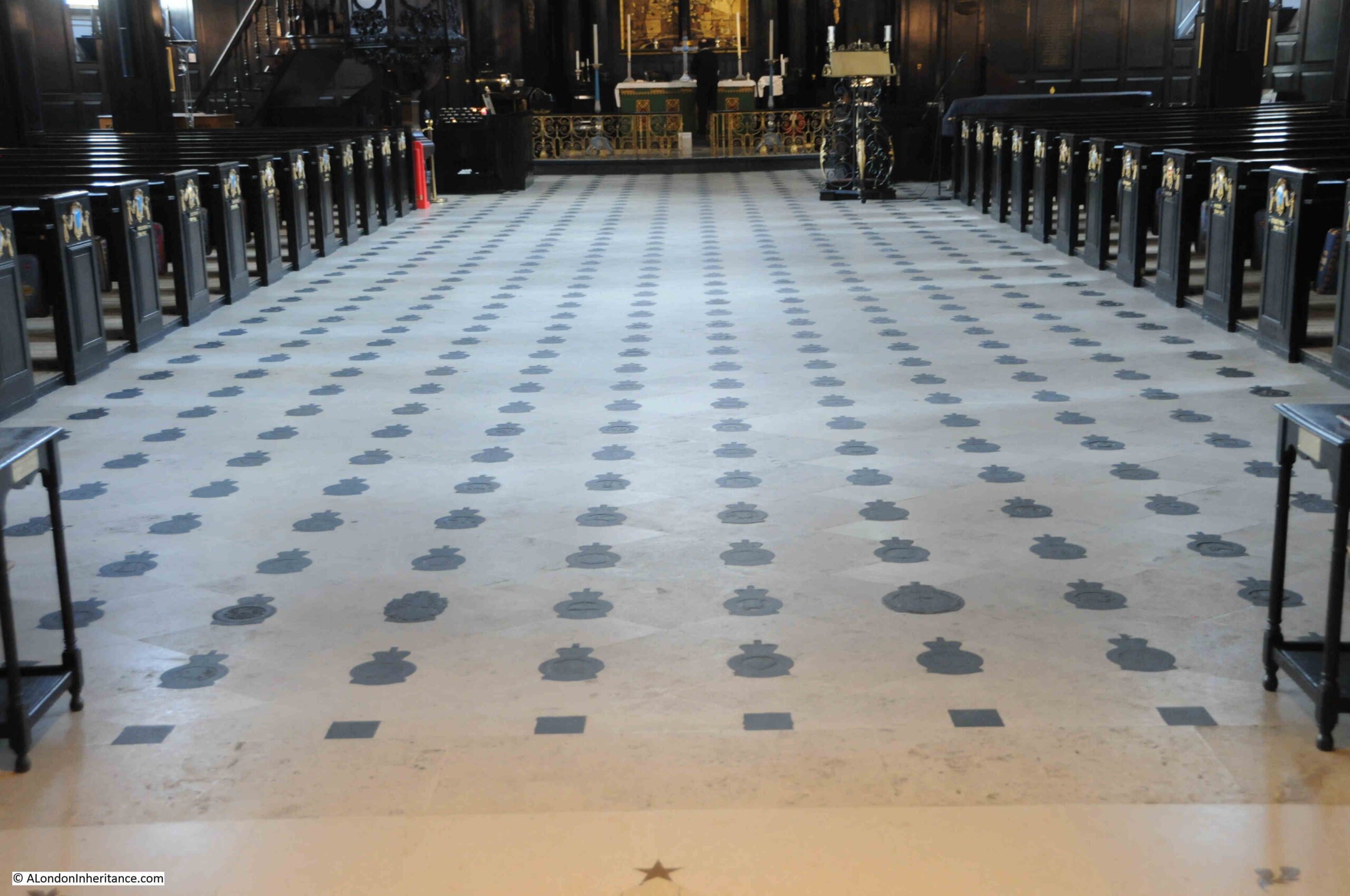
Detail of one of the badges:
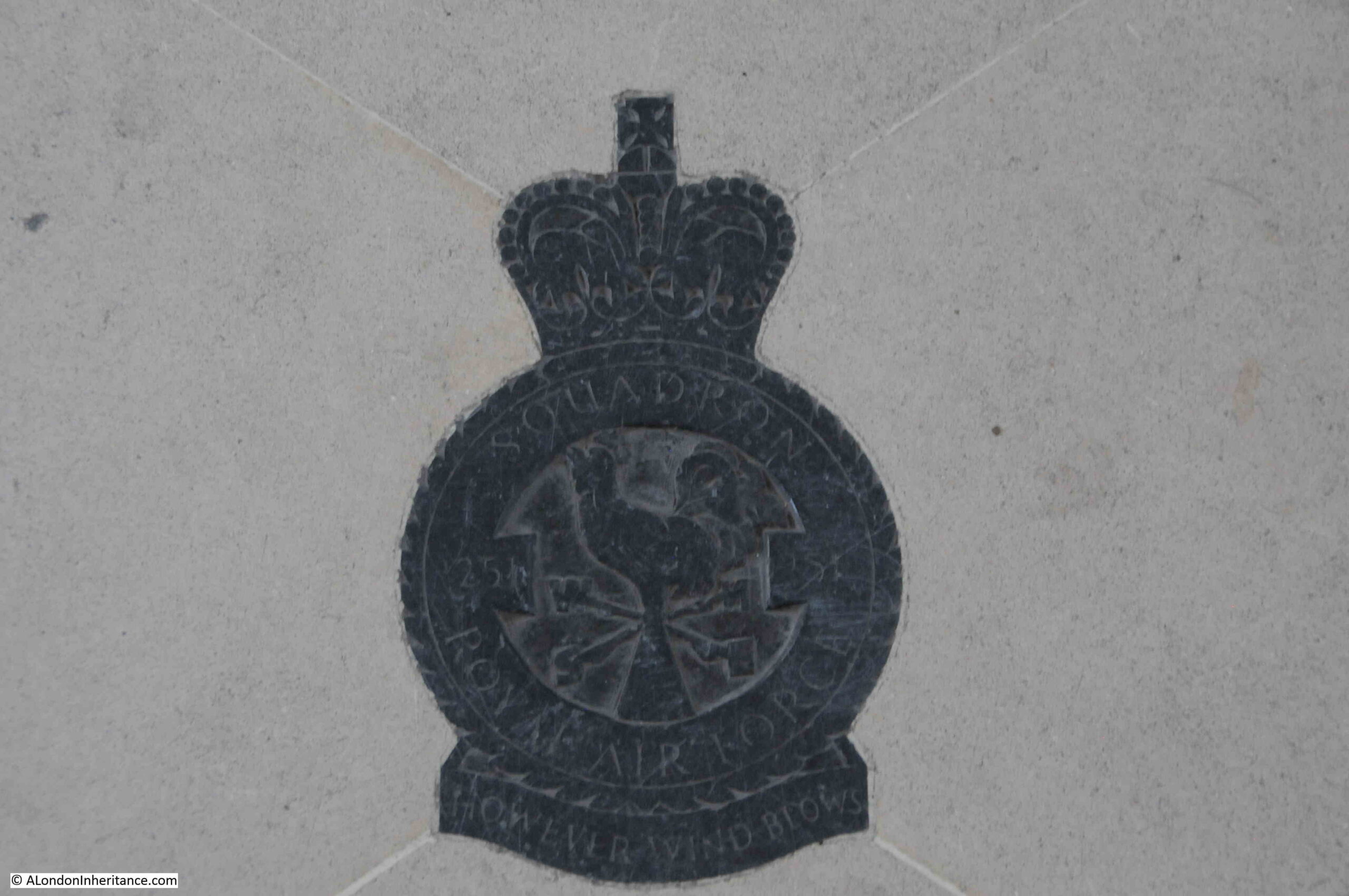
Pulpit and altar:

Along the side walls of the church are glass fronted cabinets, which contain books that commemorate over 150,000 people who have lost their lives whilst serving in the RAF. These cabinets are topped by the same dome shape that can be seen on the front of the church, to either side of the steeple.

The above photo is off the northern side of the church, the following is the southern side, again showing the books in their cabinets lining the side of the wall.
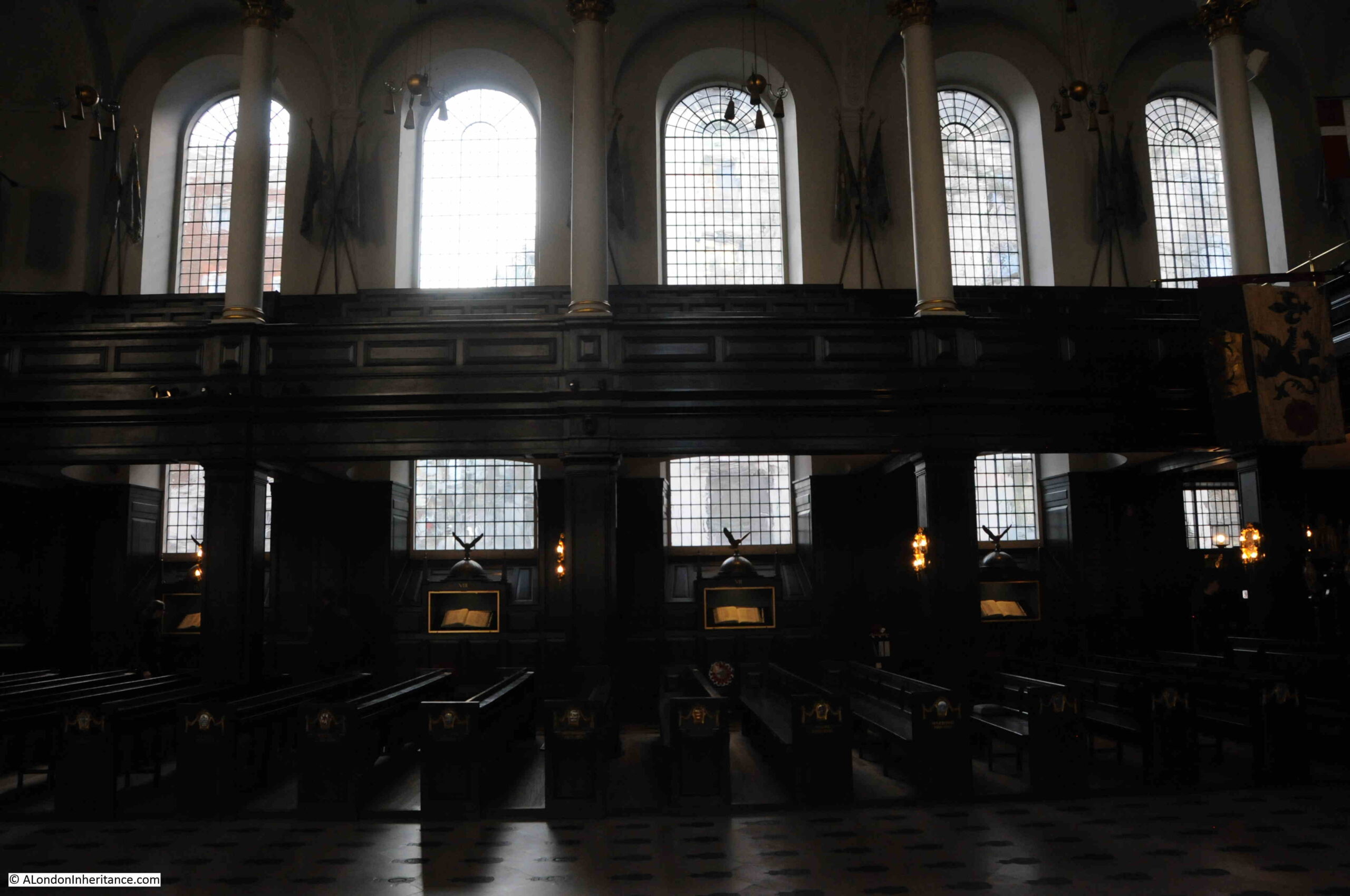
The ends of the pews have cartouches of the Chiefs of the Air Staff, including Charles Portal who occupied the position for the majority of the Second World War.
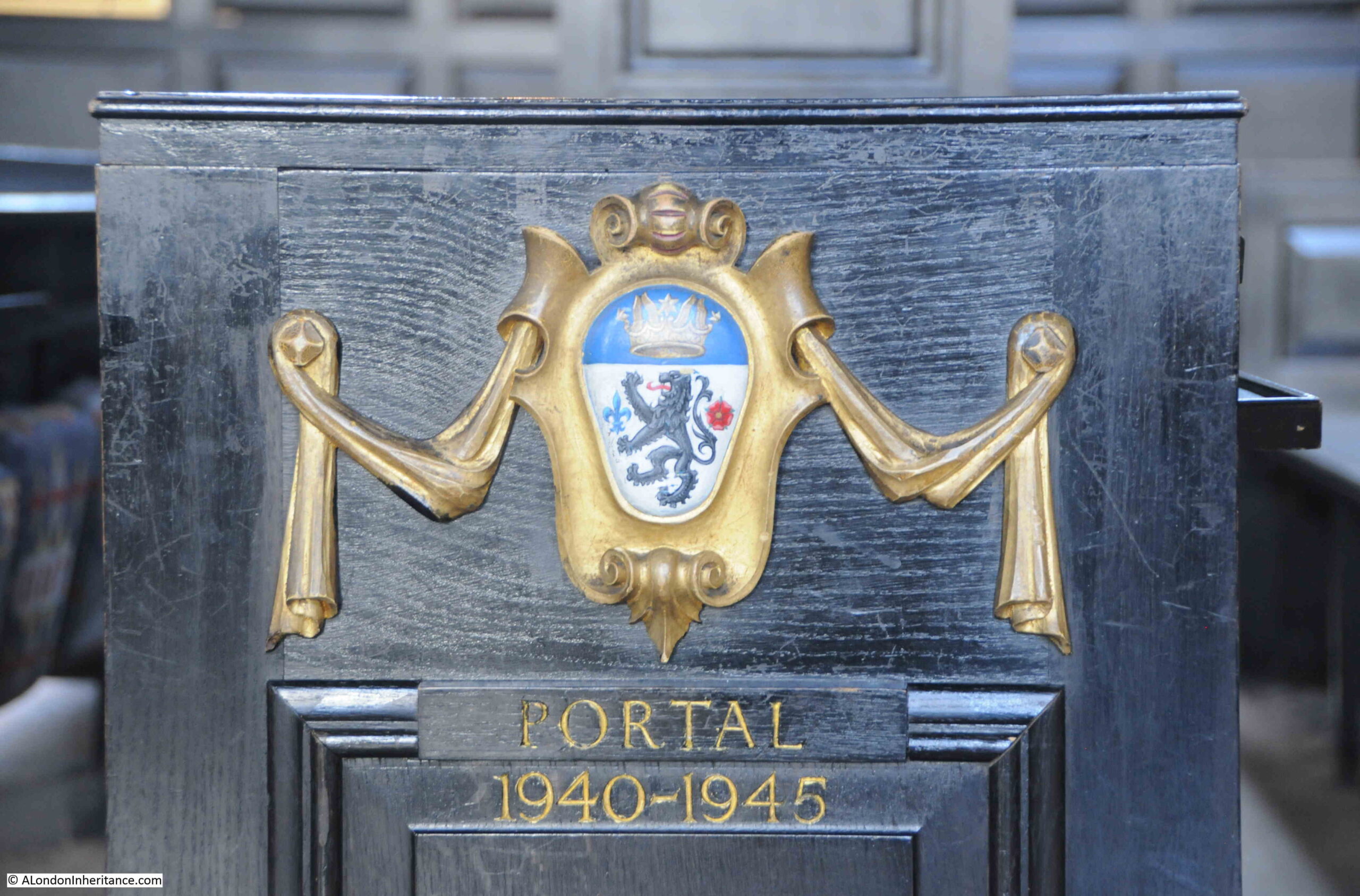
In the church is a photo of when the church was bombed. As well as the main body of the church, fire reached up through the spire which created this dramatic photo of the church’s destruction:
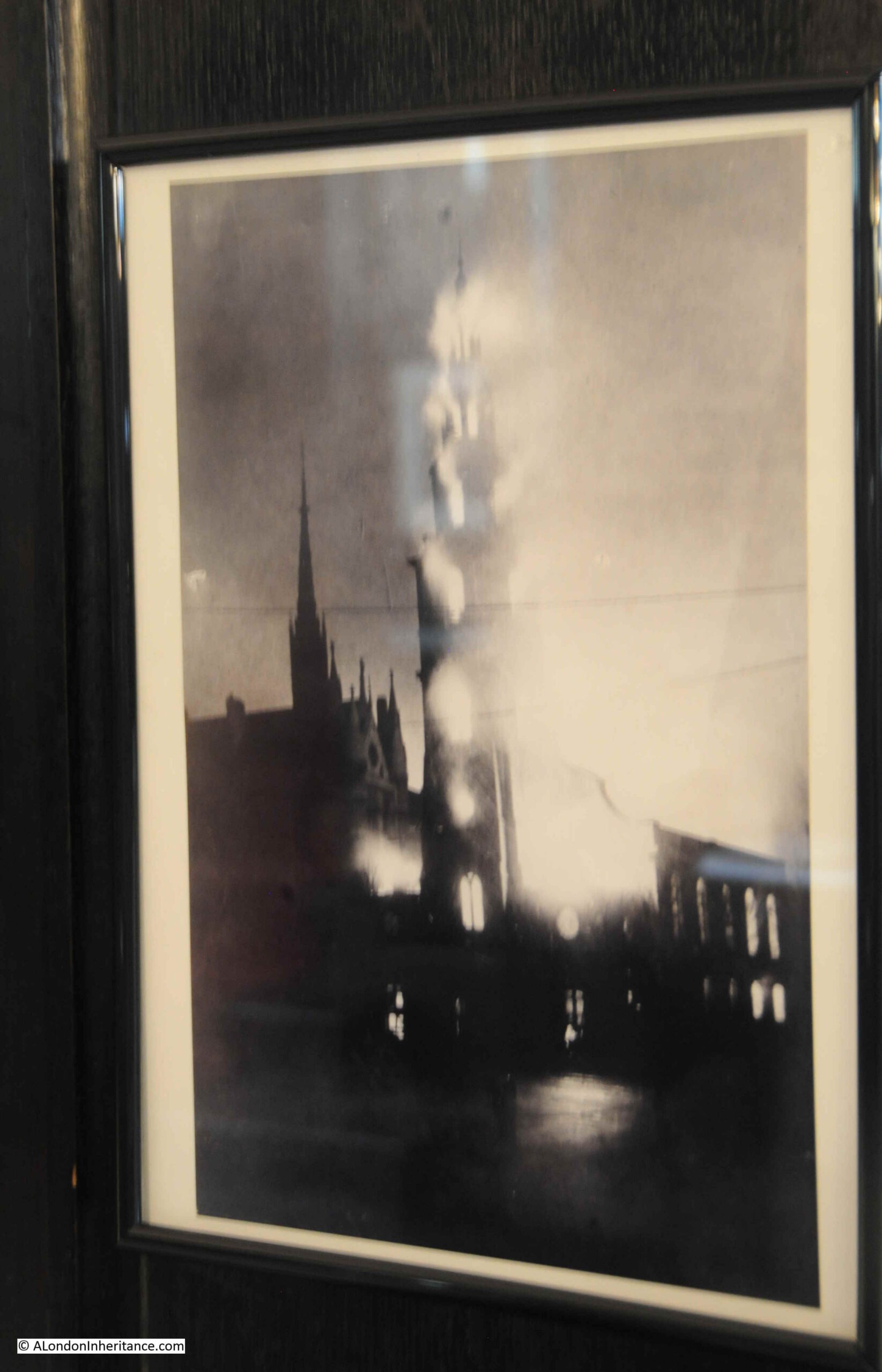
Although the church was rebuilt by Wren, he had started on the tower but had ;left it unfinsihed. In May 1719, the church vestry decided to let John Townsend build on the tower, using a design for a steeple by James Gibbs.
Gibbs also followed up with some work on repairs to the roof and some of the decorations within the church.
More RAF insignia on the floor of the church:

One of the stories about the originas of the church states that it was “founded on the site of a well outside Temple Bar”. Back outside the church, and by the eastern end of the church there was a well, but it was not the one on which the church was founded:

The date 1807 is presumably when the well was sunk, 191 feet below to find water.
Interestingly (or at least to me), a bore hole was sunk in front of the church for London Transport in August 1969.
This bore hole found water at around 85 feet. The records of the borehole indicate that the depth of water changed by the hour and by the day, fluctuating by as much as 20 feet. The chucrh is close to the Thames, and the effect of the tide can be seen in ground water levels, so perhaps the tides of the Thames shape the height of the water table below St. Clement Danes.
Close to the location of the old well is a statue of Samuel Johnson, the 18th century critic and essayist:
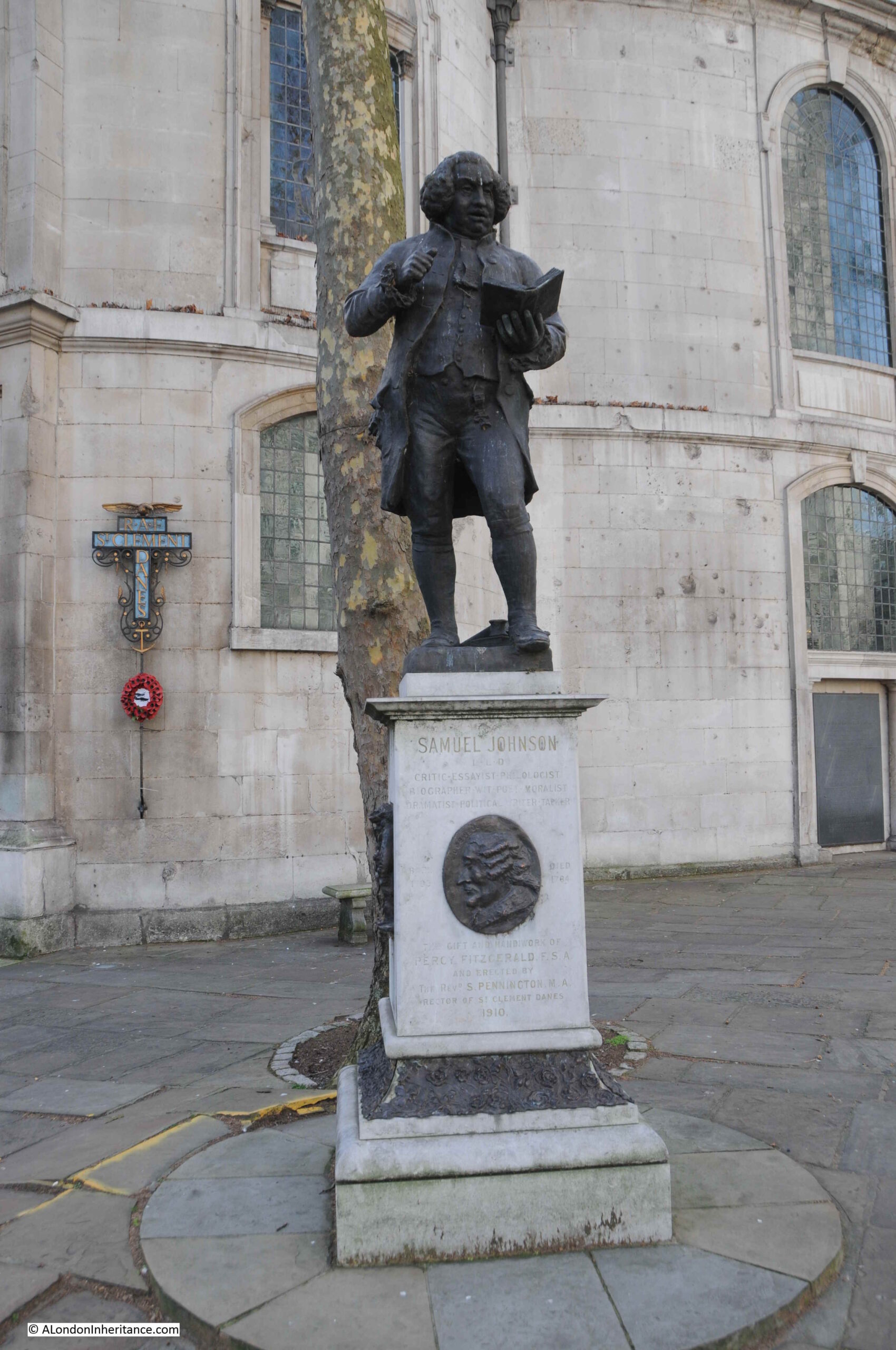
St. Clement Danes was the church that Samuel Johnson attended, and the statue was donated by the Rev. J.J.H. Septimus Pennington, who died in 1910, when the statue by Percy Fitzgerald was unveiled by Princess Louise, Duchess of Argyll.
Rev. Pennington also put up stained glass windows to Dr. Johnson and carefully preserved his pew.
Statues to the front of the church relate to the church’s current relationship with the RAF, including Lord Dowding, Commander in Chief of Fighter Command during the last war:
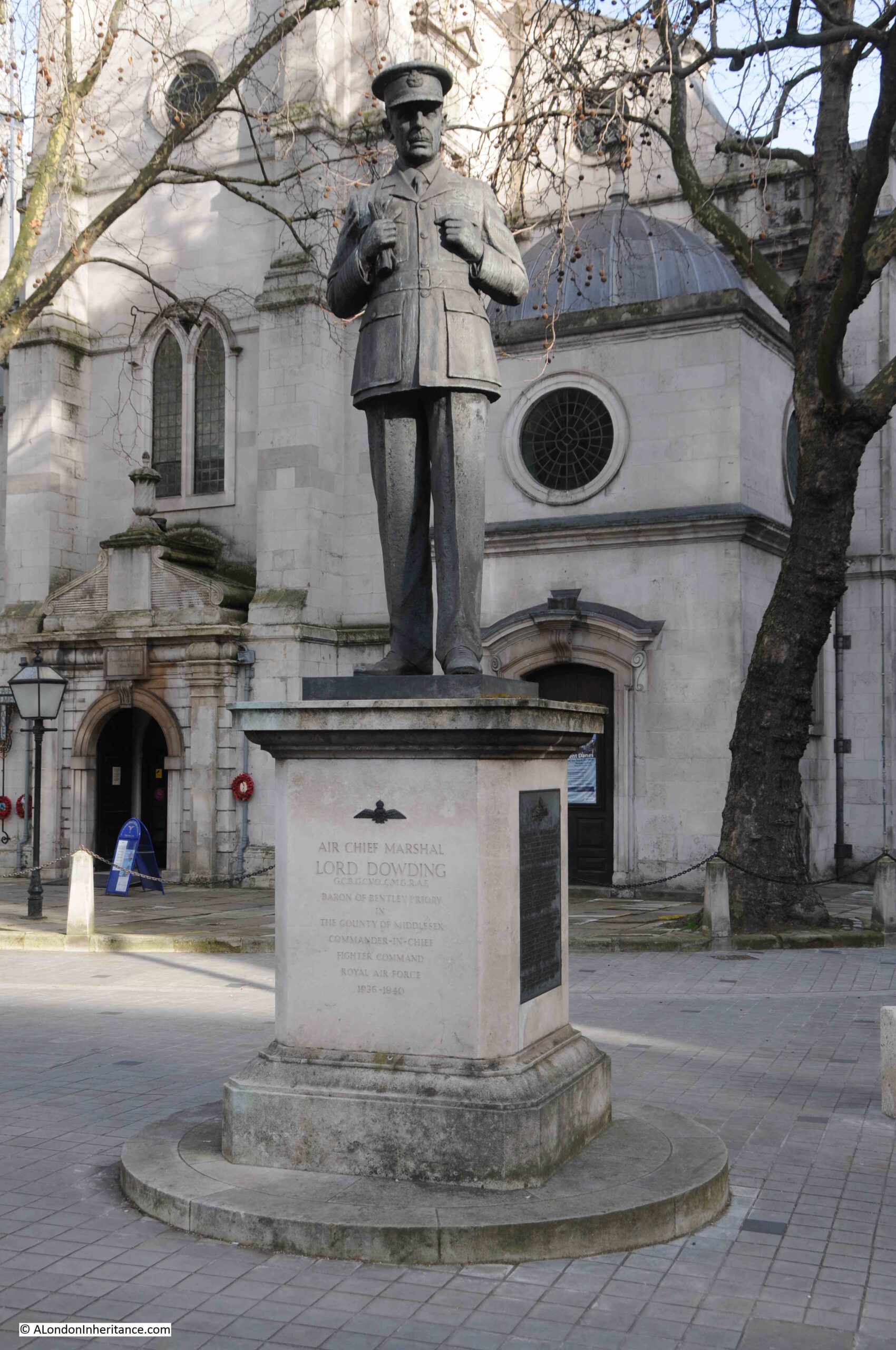
And Sir Arthur Harris, the head of Bomber Command:

The memorial to Harris also records the more than 55,000 members of bomber Command who lost their lives.
There is a large pedestrianised area in front of the church, and at the western end of this is a large monument (if you look back at the photo at the top of the post, you can see the top of the monument at the bottom of the page and the street that once ran between monument and church).

This monument is to William Gladstone who stands on the top of the monument looking west. Gladstone was Prime Minister a number of times during the second half of the 19th century.
Reminiscent of the Victorian approach to adorning monuments, whilst Gladstone is at the top, around the pedestal are depiction of Brotherhood, Education, Courage and Aspiration:
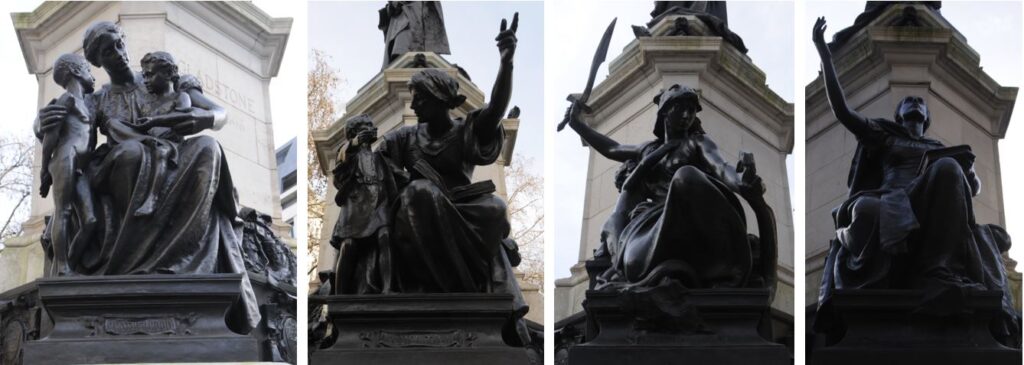
The sculpture is the work of Sir William Hamo Thornycroft, who was a prolific producer of works seen across London and the wider country.
The statue of Oliver Cromwell outside the Palace of Westminster is another example of the work of Thorneycroft, and his name can be seen on the base of the Gladstone memorial:
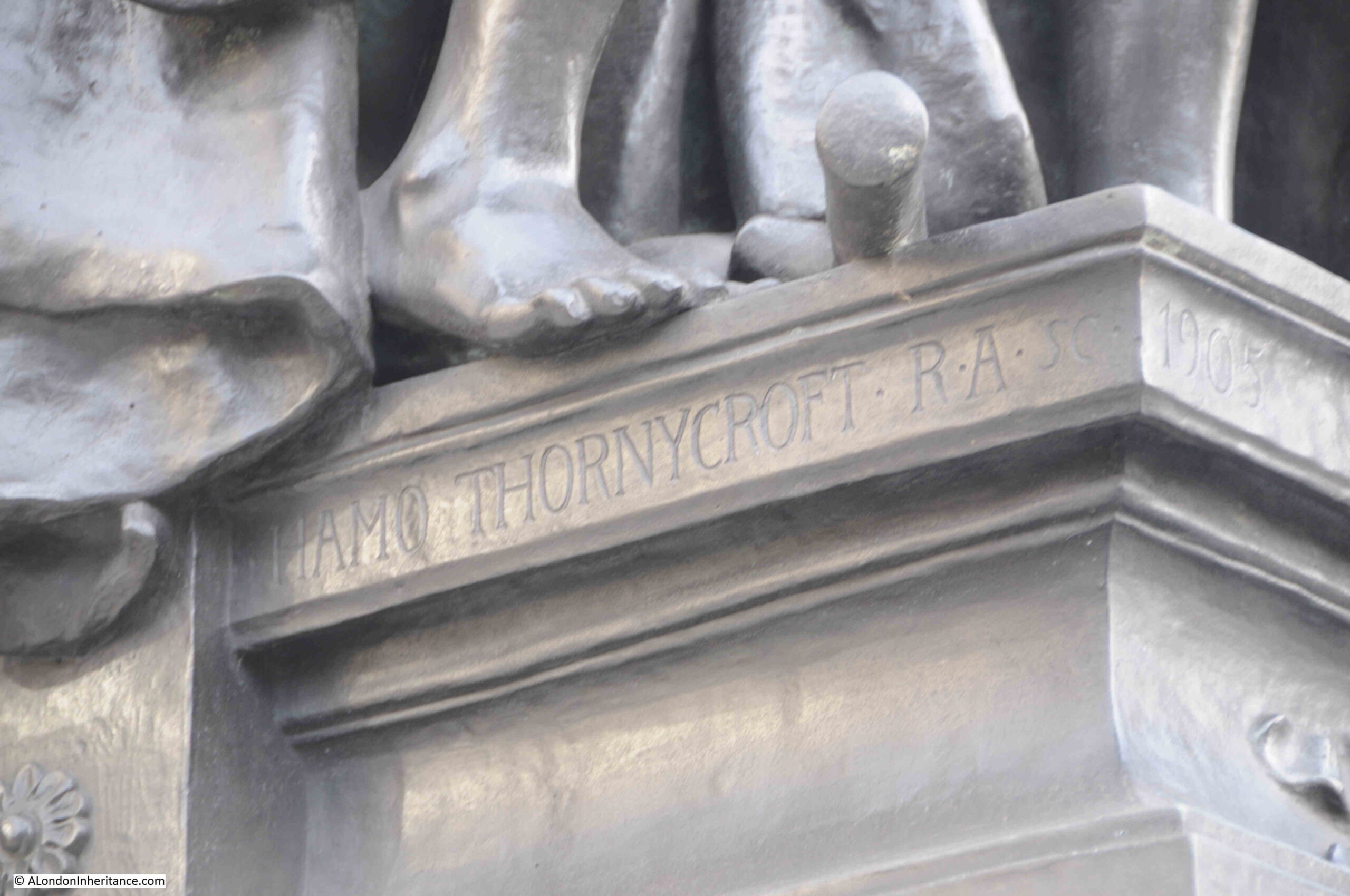
St. Clement Danes is a lovely church in a prominent position in the Strand. A church has been on the site for very many centuries, and it is impossible to be sure as to how long this has been a religious place, and whether the Danes had any involvement in the founding or naming of the church.
There is one final story about the church. It is one of the two candidates for the St. Clement mentioned in the nursery rhyme “Oranges and Lemons”, where the first verse is:
Oranges and lemons,
Say the bells of St. Clement’s
The other candidate being St. Clement Eastcheap in the City. There was an “Oranges and Lemons” service held in the church and this was revived in 1959, as this report from the Daily Mirror on the 19th of March 1959 describes:
“The traditional ‘oranges and lemons’ service was revived yesterday for the first time since the war at the church of St. Clement Danes in the Strand, London.
The service marks the link between the church and the oranges ad lemons nursery rhyme. About 500 youngsters went along and the Rev. G.W.N. Groves handed out lemons while the Ven. A.S. Giles presents the oranges.”
There is a wonderful video on YouTube showing the dedication of the bells before they are mounted in the tower during post war reconstruction,. During the ceremony the tune for Oranges and Lemons is played on the bells, and the video shows the level of damage that the church sustained.


https://www.crouchrarebooks.com/prints/p-is-for-peruke-maker
And Samuel Johnson had a very interesting life. Maybe his hair was fashioned by Holmes on Essex Street.
.https://www.bbc.co.uk/history/historic_figures/johnson_samuel.shtml
“In the Netherlands the word Strand is still used for a beach.” And in Germany; Travemünde, on the Baltic coast, has the Maritim Strand hotel and a Strand station.
It is interesting, surely, that the Rocque map of 1740 shows Holy-well Street running parallel to Strand ? Does this suggest more evidence for an earlier well ?
I’ve been lucky enough to sing in a concert at St Clement Danes a couple of times. With everything that goes on during rehearsal and performance, there’s not a lot of time to take in the finer detail of the building so I’m grateful to you for showing me what I missed.
Thank you, that is a really lovely post. The destiny of this Church changed enormously recently thanks to SAVE Britain’s Heritage’s sterling work to rescue the remaining Georgian houses that flank the hideous Kings College facade when they proposed demolishing them six or seven years ago. The university had been already for knocking down the Fishmonger, Coal Merchant, Ironmonger and Straw hat Maker’s houses). The houses that were left meant that Somerset House had a symmetric row of ancient buildings to either side of it. SAVE, as is their usual modus operandi, not only protested against such a vandalous proposal, but put forward an alternative plan based on the brilliant idea of pedestrianising the south part of the Aldwych and creating a whole new public realm around the church between the old BBC World Service Building (now owned by Kings College) and the brutalist uni building. And the Kings’ College powers-that-be accepted it!! Now trees have been planted, lawn and paving laid, seats installed, lighting added…it looks amazing and the rector of the Church is overwhelmed by the number of visits it now gets. All that is required now is for Kings to do the decent thing and restore the remaining old houses. I wholeheartedly recommend visiting the Church at sunset as the sun goes down right in the axe of the Strand – it is a glorious view. SAVE is an amazing David-and-Goliath independent charity that does so much good work (the Museum of London’s fabulous new home in Smithfield Market is also down to their enterprise) – do support them if you love London as they depend entirely on public donations. PS Despite my knowing a lot about this area and loving the evolution of the area, I was unaware of Samuel Johnson’s statue nor his connection with the Church. As a big fan, I shall return to see this with my own eyes.
Very interesting, thanks for these details about SAVE.
Sorry but you are confusing St Clements with St Mary le Strand.
The traffic still runs past St Clements which is east of St Mary.
I will double check the wording of my post, but the reference to the pedestrianised area is to that between the front of the church and the Gladstone memorial, where there was once a roadway between the monument and the church.
Hi admin!
My comment was directed to Alison. What she describes is the area around St Mary Strand.
Fascinating account. Thank you.
Interestingly, in Ireland also the word to describe the sea or river shore is strand.
Thanks for including all the maps to further understand the physical relationship with the Strand.
Thank you. St Clement Danes is a lovely church both inside and out.
Geologists call any beach or mark on the ground that marks a previous water (lake or ocean) level, a “strand line”.
A fascinating post – thanks also for the inclusion of an atmospheric film clip that really gives a feel for the post-war reconstruction/reconsecration of the site.
I sing regularly in a different London St Clement’s from either of those you mention (St Clement’s Finsbury) – I think they all battle for the coveted ‘Oranges and Lemons’ nursery rhyme association!
Yet another excellent post. Thank you so much.
My most favourite of all Churches in London. The books in the glass cabinets bear the names of those in the RAF who were killed, and the pages are turned regularly. This editorial captures perfectly the serenity and beauty of St Clements despite the noise of traffic from all sides of the building. Thank you for sharing your pictures, past and present.
I was married in St Clement Danes on the 11th January 1969! and I remember it well. We had to obtain a special permission document from the Bishop of London to get married there as it was not a parish church but the RAF chapel. I was allowed to be married there as my father was in the RAF and gave his life in the second world war and his name etc is recorded in the book of remembrance that is lodged in the church. We had both the bells and the organ participating. A memorable day. Thank you for a lovely article – as usual.
The Liberal William Ewart Gladstone was prime minister in four administrations (1868-1874, 1880-1885, 1886, and 1892-1894), one more than Robert Gascoyne-Cecil, 3rd Marquess of Salisbury, the Conservative prime minister (1885-1886, 1886-1892, and 1895-1902).
outstanding work; i appreciate the links. Forgot to acknowledges the outstanding and inviting graphics
My daughter and son in law are both serving officers in the RAF which is one reason for my interest in the story of st Clement Danes. However long before my father took me on a visit or one of many visits to notable places in London and I remember very clearly he told me the story of the church . And that has stuck in my brain ever since I am now 78. I do enjoy your blogs so thank you.
Another excellent article. The church is a lovely place to visit. oranges and lemons theme is rung on each hour I think.
You may want to revisit St.. Clement Danes now that a new pedestrian space has been created.
Very interesting read
Another brilliantly thorough job. The maps were helpful and the film was a splendid end piece. The 1920s photo at the beginning made one wish for a similar skyline today.